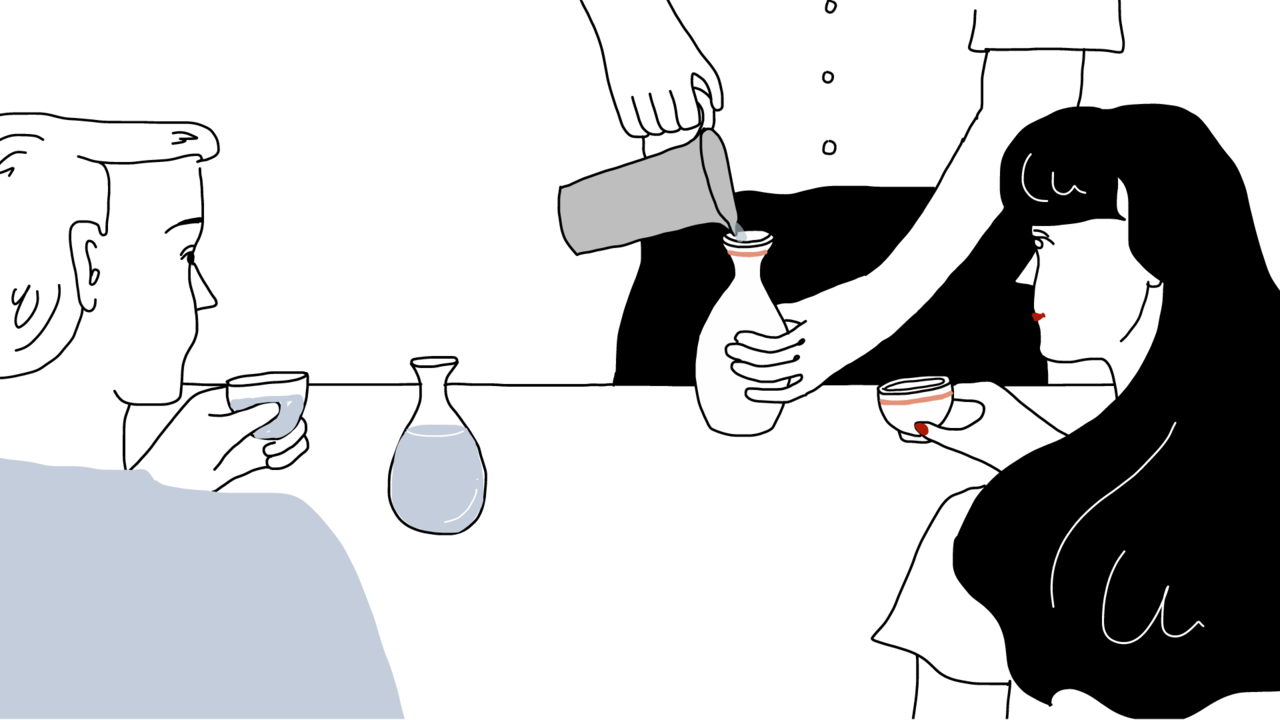
Know Your “Nihonshu”: How Serving Temperature Affects Flavor
Guideto Japan
Culture- English
- 日本語
- 简体字
- 繁體字
- Français
- Español
- العربية
- Русский
BARKEEPER Irasshai! Kaori-san, Joe-san, how are you? Our special today is nikujaga.
JOE Did someone say niku?
BARKEEPER Meat, potatoes, and onions stewed together in a sweet and savory broth. It’s a Japanese family favorite.
KAORI Nikujaga sounds great. So, maybe tonight we should go with okan?
JOE What kind of sake is that?
KAORI That’s what we call sake served warm.
Warm Sake in Warm Weather?
JOE Oh, right. But . . . it’s summer. Isn’t hot sake something you drink in the wintertime? Like mulled wine? I had that when I was in France—red wine heated with spices and fruit. But that was in winter.
KAORI Ah, vin chaud, right? That’s actually served hot, but with nihonshu, we have a lot of temperature options. You can drink it lukewarm, for example—nuru-kan.
JOE But who wants a warm drink when it’s so hot outside?
BARKEEPER Well, keep in mind that you’re indoors, where it’s air-conditioned. Besides, a lot of people believe that warm drinks are easier on the system, since they’re closer to body temperature. The famous Edo period physician Kaibara Ekiken [1630–1714] recommended drinking sake okan all year round as a key to long life. For a while, my younger customers were ordering nothing but chilled ginjō-shu and sparkling sake. But now it seems they’re rediscovering the appeal of warm junmai-shu—and not just as a winter drink.
KAORI It really hits the spot if you’re feeling drained by the hot weather. Want to give it a try?
JOE Sure, why not? Not too hot, though.
BARKEEPER Let’s go with junmai-shu, since most people think ginjō and daiginjō are best served at lower temperatures. (Placing tokkuri flask and two ochoko cups before Kaori and Joe) This junmai-shu has been heated to just 35 degrees Celsius, a little below body temperature. This is what we call hitohada-kan.
A Whole New Experience
KAORI Wait, let me pour for you. (Pouring sake from tokkuri into Joe’s ochoko) Ikkon, dōzo.
JOE Now I get to pour for you, right? Oh good, I’ve always wanted to do this—just like in the old Japanese movies.
BARKEEPER There’s an expression for this back-and-forth: sashitsu sasaretsu.
KAORI Thank you, Joe. Mmm! At this temperature, it kind of suffuses your whole body. And it goes great with a simmered dish like nikujaga.
JOE It’s very smooth and soft. Hitohada—skin temperature, right? I like it.
BARKEEPER Okay, now try the same sake at 45 degrees Celsius. We call this jōkan.
JOE Wow, it comes on a lot stronger. It hardly tastes like the same sake!
KAORI This really makes you sit up straight! I’d say this is another good temperature for summertime drinking.
BARKEEPER There are so many options: 30 degrees Celsius is called hinata-kan [“sun-warmed”]. Nuru-kan [lukewarm] is 40 degrees. For those who like their sake on the hot side, atsu-kan [hot] is 50 degrees, and tobikiri-kan [extra hot] is 55 degrees.
JOE Wow, so that’s, like, six different terms!
BARKEEPER And we haven’t even gotten to reishu [chilled sake]. Yuki-hie [“snow-cold”] is 5 degrees Celsius, hana-hie [“cherry-blossom-cold”] is 10 degrees, and suzu-hie [“evening cool”] is 15 degrees.
JOE Such poetic, seasonal names—almost like haiku!
BARKEEPER One of the things that makes nihonshu so special is this range of possible serving temperatures and the way they change the drinking experience. Depending on the type of sake, you can adjust the temperature to suit the food, the weather, the occasion, or just your mood.
How to Heat Your Sake
KAORI So, how do you heat your nihonshu here at the sake bar?
BARKEEPER I use the traditional hot-water-bath method, what we call yusen. I keep a big pot of hot water. The sake goes into tin ewers called chirori, with handles that hook onto the edge of the pot. I immerse the chirori in the hot water until the sake reaches just the right temperature, then transfer it to the tokkuri. In the old days, there were actually professional sake warmers called okanban.
At home, you can just submerge the tokkuri directly in a pot of very hot water. Make sure the water comes up about two-thirds of the way to the top of the tokkuri. You can even use the microwave, as long as you have a microwave-safe tokkuri or other nonmetal vessel. But the microwave doesn’t heat the top and bottom evenly, so it’s best to transfer the sake to another tokkuri before serving.
KAORI That sounds easy enough. Hey, I know! Let’s have a sake-tasting party this weekend at my place. I’ve already got some in the fridge, so we can have reishu, too.
JOE Cool! You and me?
KAORI Yeah, and Li-san and Chang-san and Maria and Jose . . . the more the merrier!
JOE Oh sure. The more the merrier.
KAORI What’s the matter?
JOE Nothing! What a great idea. Let’s ask everyone to bring a small bottle. I can hardly wait.
In the meantime . . . could I have my reishu now?
Illustration: The barkeeper pours heated sake from a tin chirori into a ceramic tokkuri. Kaori sips her warm sake from a small ochoko. A glass ochoko like Joe’s is often preferred for chilled sake.
- “Nihonshu” Now : Behind the Global Sake Renaissance
- Know Your “Nihonshu”: Understanding Sake Brewing
- Know Your “Nihonshu”: Types of Sake and Their Characteristics
- Know Your “Nihonshu”: Sake Tasting Demystified
- “Nihonshu” Now: Yamagata and the Sake Renaissance
- Know Your “Nihonshu”: Sake Wisdom for Guilt-Free Drinking
- “Nihonshu” Now: Japanese Brewery Senkin Rewrites the Sake Rulebook
- Know Your “Nihonshu”: The Many Faces of Sparkling Sake
- “Nihonshu” Now: Adventures in Creative Sake Pairing
